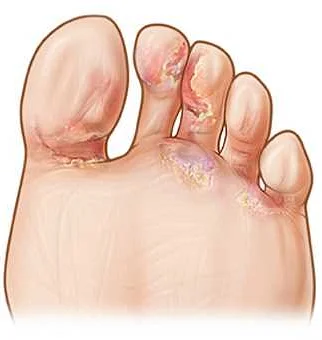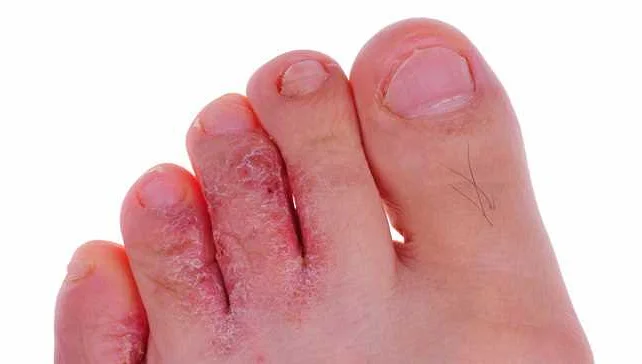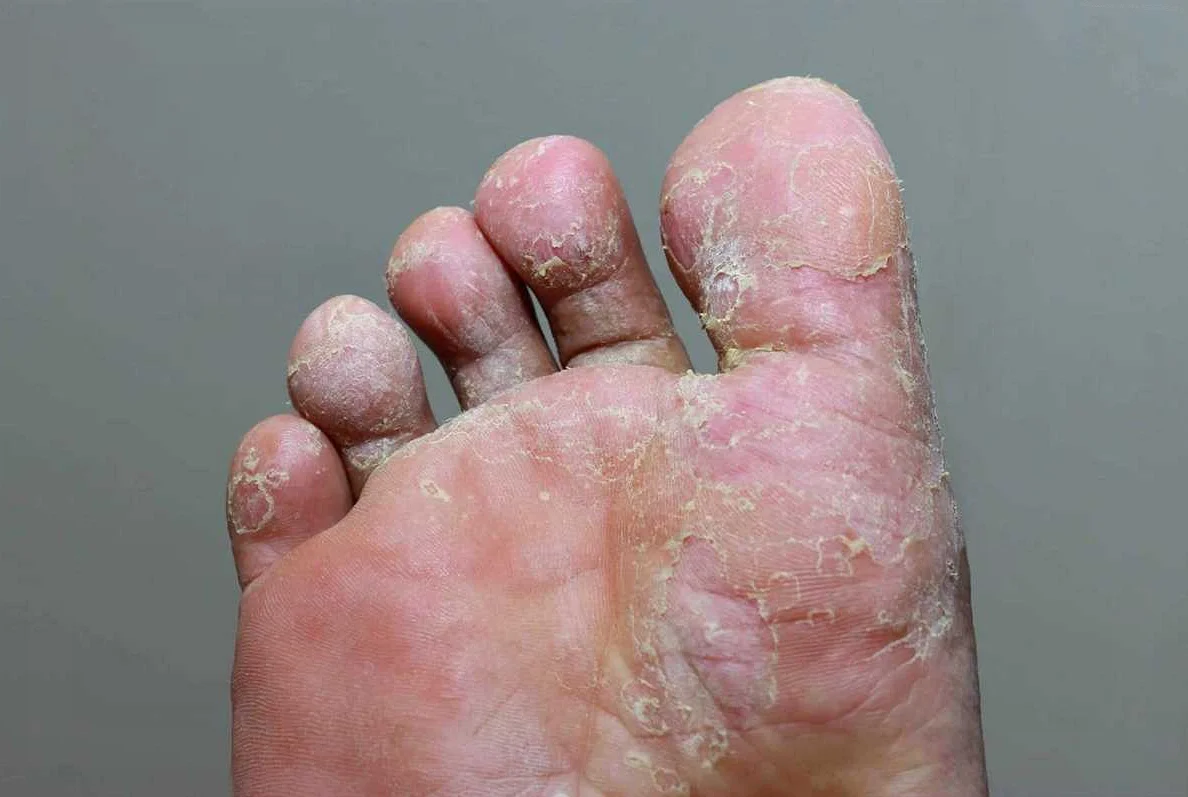Foot fungus: photos, symptoms, treatment
Содержимое
Learn about foot fungus, including common symptoms, see photos of different types of foot fungus, and explore treatment options to help you find relief and prevent future infections.
Are you experiencing discomfort, itchiness, or a foul odor coming from your feet? You may be dealing with a common condition known as foot fungus. Foot fungus, also referred to as athlete’s foot, is a contagious infection that primarily affects the skin on the feet. It is caused by various types of fungi and can be easily contracted in public places such as locker rooms, swimming pools, and communal showers.
So, how can you identify if you have foot fungus? Look for symptoms such as redness, cracking, and peeling skin between the toes, itching, burning, and blisters. In some cases, the infection may spread to the toenails, causing them to become discolored, thick, and brittle. If you notice any of these signs, it’s important to seek treatment as soon as possible to prevent further complications.
Fortunately, there are several treatment options available to help you combat foot fungus. Over-the-counter antifungal creams and powders can help relieve symptoms and eliminate the infection. It’s important to follow the instructions carefully and continue treatment for the recommended duration to ensure complete eradication of the fungus. In severe cases, your healthcare provider may prescribe oral antifungal medications or recommend other treatment methods such as medicated foot soaks.
Prevention is key when it comes to foot fungus. To keep your feet healthy and fungus-free, make sure to practice good foot hygiene. Always keep your feet clean and dry, especially between the toes. Wear clean socks made of breathable materials that wick away moisture and change them regularly. Avoid walking barefoot in public areas and make sure to wear sandals or flip-flops when visiting places like gyms or pools. Additionally, it’s important to refrain from sharing towels, shoes, or socks with others to minimize the risk of infection.
Don’t let foot fungus disrupt your daily activities and cause discomfort. With proper care, treatment, and prevention, you can maintain healthy feet and enjoy life to the fullest. If you suspect you have foot fungus, consult with a healthcare professional for an accurate diagnosis and personalized treatment plan. Remember, healthy feet are happy feet!
Foot Fungus: Photos, Symptoms, Treatment – Your Guide to Healthy Feet
Foot fungus, also known as athlete’s foot, is a common condition that affects many people. It is caused by a fungal infection that can occur on the skin of the feet, particularly between the toes. If left untreated, foot fungus can cause discomfort and pain, and may even lead to more serious complications.
One of the most common symptoms of foot fungus is itching and burning between the toes. The affected skin may also become red, cracked, and swollen. In some cases, blisters may develop. It is important to recognize these symptoms and seek treatment as early as possible to prevent the infection from spreading.
There are several treatment options available for foot fungus. Over-the-counter antifungal creams and powders are often effective in treating mild cases. These products typically contain ingredients such as miconazole or clotrimazole that can help kill the fungus and relieve symptoms. It is important to use these products as directed and for the full recommended duration to ensure complete eradication of the infection.
In more severe cases, prescription antifungal medications may be necessary. These medications are usually taken orally and can be more potent than over-the-counter options. Your healthcare provider can determine the best course of treatment based on the severity of your infection.
In addition to medication, there are several measures you can take to prevent foot fungus and maintain healthy feet. It is important to keep your feet clean and dry, especially between the toes. Wearing moisture-wicking socks and breathable shoes can help prevent the growth of fungi. It is also important to avoid walking barefoot in public areas such as locker rooms and communal showers.
In conclusion, foot fungus is a common condition that can cause discomfort and pain. Recognizing the symptoms and seeking treatment early is essential to prevent the infection from spreading. With proper treatment and preventive measures, you can maintain healthy feet and avoid future infections.
Understanding Foot Fungus

Foot fungus, also known as athlete’s foot or tinea pedis, is a common fungal infection that affects the skin of the feet. The infection is caused by various types of fungi that thrive in warm and moist environments, such as locker rooms, swimming pools, and communal showers.
Foot fungus is highly contagious and can be easily spread from person to person or by indirect contact with contaminated surfaces or objects. It can also be transmitted through shared footwear or socks.
The symptoms of foot fungus typically include itching, redness, and a burning sensation on the affected areas. In some cases, the skin may also crack, peel, or develop blisters. If left untreated, the infection can spread to other parts of the foot, such as the toenails, causing additional symptoms and complications.
Treatment for foot fungus usually involves a combination of over-the-counter antifungal creams or sprays and practicing good foot hygiene. It is important to keep the feet clean and dry, wear breathable footwear and socks, and avoid walking barefoot in public places.
| – Itching | – Over-the-counter antifungal creams or sprays |
| – Redness | – Good foot hygiene |
| – Burning sensation | – Keeping feet clean and dry |
| – Cracked or peeling skin | – Wearing breathable footwear and socks |
| – Blisters | – Avoiding walking barefoot in public places |
If home remedies and over-the-counter treatments do not effectively clear up the infection, it is important to seek medical attention. A healthcare professional may prescribe stronger antifungal medications or recommend other treatment options, depending on the severity of the infection.
Preventing foot fungus involves taking steps to minimize the risk of exposure to the fungi. This includes practicing good foot hygiene, avoiding sharing footwear or socks, wearing breathable shoes, and regularly disinfecting shoes, socks, and other foot-related items.
By understanding foot fungus and taking preventive measures, you can keep your feet healthy and reduce the risk of infection. If you suspect you have foot fungus, it is important to seek treatment promptly to prevent further complications and discomfort.
Identifying Foot Fungus Symptoms

Foot fungus, also known as athlete’s foot or tinea pedis, is a common fungal infection that affects the skin on the feet. It is caused by various types of fungi, including Trichophyton, Epidermophyton, and Microsporum.
Recognizing the symptoms of foot fungus is crucial for early diagnosis and treatment. Here are some common signs to look out for:
1. Itching and burning: One of the most noticeable symptoms of foot fungus is intense itching and burning sensation. The affected area may feel irritated and uncomfortable.
2. Peeling and cracking skin: Foot fungus often leads to the peeling and cracking of the skin, especially between the toes. The skin may appear dry, scaly, and flaky.
3. Redness and inflammation: The infected area may become red, swollen, and inflamed. The skin may also feel warm to the touch.
4. Blisters and sores: In some cases, foot fungus can cause the formation of blisters and sores. These can be painful and may ooze clear fluid.
5. Odor: Foot fungus can cause a foul odor due to bacterial overgrowth. This odor is often described as strong and unpleasant.
If you notice any of these symptoms, it is important to seek medical advice for proper diagnosis and treatment. A healthcare professional can recommend antifungal medications or topical creams to help eliminate foot fungus and prevent its recurrence.
Preventing foot fungus is also essential. To reduce the risk of infection, make sure to keep your feet clean and dry, wear breathable shoes and socks, and avoid walking barefoot in public areas.
Remember, early detection and treatment of foot fungus can help prevent further complications and promote healthier feet.
Preventing Foot Fungus Infection

Foot fungus infections can be uncomfortable and unsightly, but the good news is that there are steps you can take to prevent them. By practicing good foot hygiene and taking certain precautions, you can greatly reduce your risk of developing a foot fungus infection. Here are some tips to help keep your feet healthy:
- Keep your feet clean and dry. Wash your feet thoroughly with soap and water every day, making sure to dry them well, especially between the toes. Moisture provides an ideal environment for fungi to grow, so keeping your feet dry is crucial.
- Avoid walking barefoot in public places. Fungus can thrive in warm, damp environments such as public showers, locker rooms, and swimming pool areas. Wear flip-flops or sandals to protect your feet from coming into direct contact with these surfaces.
- Choose the right shoes and socks. Opt for shoes made of breathable materials, such as leather or canvas, which allow air to circulate and prevent excessive sweating. Wear moisture-wicking socks that help keep your feet dry by absorbing sweat.
- Alternate your shoes. Giving your shoes time to dry out between uses can help prevent the growth of fungus. Consider having multiple pairs of shoes and rotating them to allow each pair to dry completely before wearing again.
- Avoid sharing personal items. Do not share towels, socks, shoes, or any other personal items that come into contact with your feet. This can help prevent the spread of foot fungus from one person to another.
- Use antifungal powders or sprays. If you are prone to foot fungus infections, applying antifungal powders or sprays to your feet and in your shoes can help keep the fungus at bay.
- Take care of your toenails. Keep your toenails trimmed and clean, and avoid cutting them too short or rounding the edges, as this can lead to ingrown toenails, which are more susceptible to fungal infections.
- Avoid wearing tight-fitting shoes. Shoes that are too tight can create a warm, moist environment and lead to excessive sweating, making your feet more susceptible to fungal infections. Make sure your shoes fit properly and allow your feet to breathe.
- Practice good overall hygiene. Maintaining good overall hygiene, such as showering regularly, washing your hands frequently, and keeping your living space clean, can help reduce the risk of foot fungus infections as well as other infections.
By following these preventive measures, you can greatly reduce your risk of developing a foot fungus infection and enjoy healthy, happy feet.